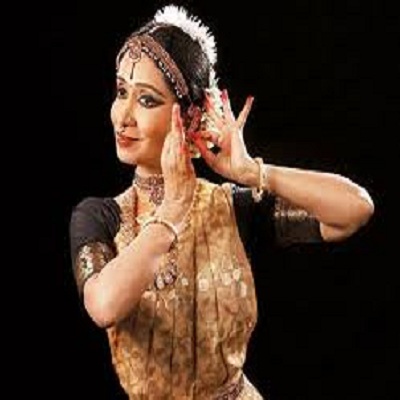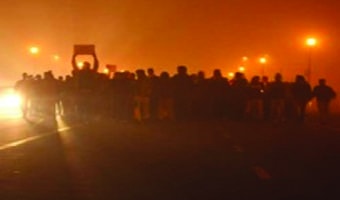
SAVAL-JAVAB
Dancer as poet, painter, actor
Alarmel Valliin conversation with Charukesi
Sankalp Meshram’s film on Bharatanatyam dancer Alarmel Valli screened for an invited audience in three theatres in Chennai in November this year, has been critically acclaimed as one of the finest attempts in portraying the life of an artist Lasya Kavya. (Directors G. Aravindan and Prakash Jha have made films on Alarmel Valli.) In the film, Zubin Mehta, Dr. M.S. Swaminathan, Mrs. Y.G. Parthasarathy, Chitravina Ravikiran and Bombay Jayashri paid glowing tributes to Alarmel Valli and her art. Excerpts from an interview with Valli:
How did the film come about?
Sankalp Meshram was the editor for Pravahi, an earlier film on me by Arun Khopkar, which was made by the Films Division, for the national archives. From very early in my career, I have danced in a number of documentaries, including the one by BBC. I think the first international documentary on India in which I featured was by a Belgium filmmaker Van Den Eynde, when I was around 15. But on the whole, I have been very remiss about recording my dance.
Lasya Kavya began initially as purely an archival project to record some of my work. But Sankalp Meshram is a director who is not only knowledgeable about music, but also a great believer in my dance and sensitive to its nuances. He was keen on making a documentary that would take a lyrical look at the intellectual, emotional and spiritual contexts within which I perform. His enthusiasm and commitment persuaded me that it was the right time to work on an in-depth film on my dance which would also explore the ideas that shape my creative work.
The film examines my belief that through dance a dancer can be at once poet, painter, actor and singer. Sankalp Meshram is a sensitive filmmaker. More important, as a dancer, I greatly appreciate the fact that he has not allowed his cinematic ideas to compromise or in any way overshadow the dance. The camera crew led by Vivek Shah was excellent and it was a pleasure to see how perceptively and beautifully they recorded the dance on film, capturing even minute flickers of emotion.
Does the film focus more on your work or you as a person?
Sankalp insisted he should include archival footage and glimpses of my childhood that included a sequence from my arangetram at the age of nine. It is a complete film because there are three layers interwoven in it – my dance, my ideas on dance and a glimpse into the process that has shaped me. Hours of interviews and dance were shot, but even 77 minutes is not long enough to cover all aspects. The director has done a remarkable job of covering most of the significant aspects of my work and the philosophy behind it.
Where was the film shot?
We began shooting the dance sequences at Filmistan Studios in Mumbai, in November 2010. Here was a vast cavernous, dark place with cables snaking all over the place. The stage had been erected for dance. It was a smooth surface to dance on. But as with all filming, it was a very exhausting, even gruelling process. I would go in around 10 in the morning and filmed till 7 or 8 in the evening, with a brief break for lunch and tea. They shot the interviews in late November and again in January 2011. I was in the midst of the busiest period of my life and I did not have a single moment to prepare texts for the questions Sankalp Meshram asked me. It was even more challenging, because the questions he asked were insightful and complex. In one sense, I am glad I did not have time to prepare, because the answers were all spontaneous and deeply felt. In retrospect, I am somewhat staggered when I think of how manic my schedule was at the time. It speaks very highly of the director and the crew that even under such pressures they were able to put me at ease to draw out the best. It was a fascinating and illuminating experience to see the film taking shape from hours of diverse film rushes that had been shot. When I sat in the editing process, I had a glimpse into the enormous difference smooth and good editing could make to a film.
I also had to send a significant amount of archival footage, photos and posters from festivals abroad. It would not have been possible but for the painstaking work of my mother and my secretary Thangam. I was lucky to be able to unearth an old 8 mm film of my arangetram. Sankalp explained the importance of archival film and he has used a short clipping. I feel there is a point in one’s life and career when everything comes together and takes on a special meaning. I would like to think that the film was shot at that right moment. It was not something I strove for or even thought of before the summer of 2010. But everything came together so harmoniously and appropriately – call it providence or synchronicity – the best things in my life have happened, seemingly spontaneously. Lasya Kavya too ‘happened’ like that.
Sankalp managed to film my mother too, something which she has never permitted in all these decades of my dancing. I am so glad he managed to persuade her, since she has been largely responsible for who I am today. The film is, among other things, a tribute to all those responsible for shaping me as a dancer – my mother and my great guru-s in dance – Pandanallur Chokkalingam Pillai, Pandanallur Subbaraya Pillai and my music guru T. Muktha.
I have been blessed in all that I have achieved as a dancer. To have great guru-s is a boon and in these days of rampant commercialisation, when ideas and values like beauty and truth are often undervalued, this film is an attempt to share with the younger generation, in some small measure, the wonderful gifts I have received from my masters – to give them a glimpse into my world.
(Charukesi is a veteran freelance journalist)



